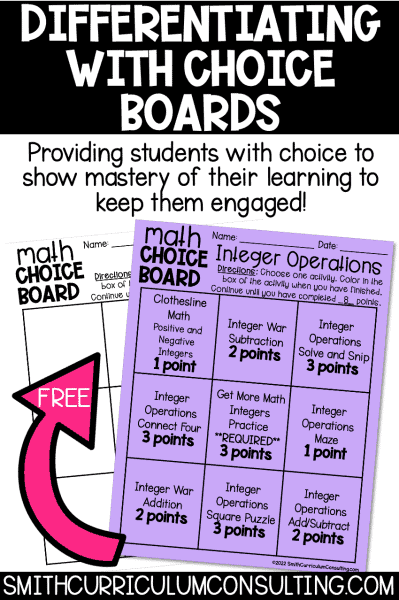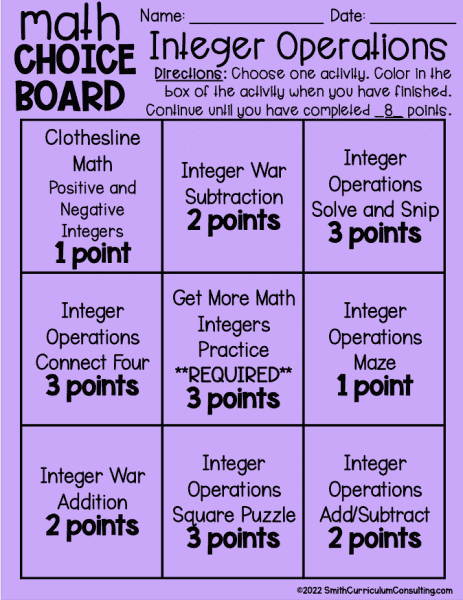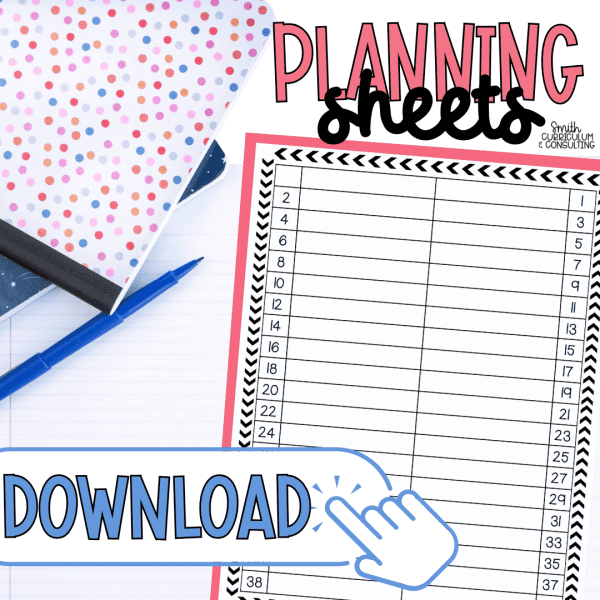
Using choice boards isn’t something new but they are something that takes a little bit of extra prep work to implement into your classroom for math workshop.
**There may be affiliate links within this post that I do earn a small commission off of each purchase.
How to Use Choice Boards for Differentiation
When I started to use choice boards, I simply gave every group the same board and had them complete 3 in a row or the entire board depending on how long we were working on each unit. I quickly learned that this was easier for me BUT it wasn’t equitable for all of my learners. I knew that I had to change things up so I wanted to implement a point system to differentiate student’s requirements but still have them work with the same boards. Each activity on the board was worth a different amount of points to make (based on complexity) and students had different amounts of points I would require them to get as part of their completion grade for Math Workshop.
Breaking Down a Differentiated Choice Board
 Creating the differentiated choice board isn’t hard, because honestly after you add the activities it is all about assigning point levels for each activity.
Creating the differentiated choice board isn’t hard, because honestly after you add the activities it is all about assigning point levels for each activity.
As you can see, this board requires the student to get 8 points total. There is a required activity in the center of the board for Get More Math practice which will automatically earn them 3 points. Typically this would be an assigned activity worth anywhere from 6-9 points that the students would work on and complete.
Activity 1: Clothesline Math– this is something that I actually keep up all year long and have a vertical and horizontal form. We use a real 1/4″ twine clothesline and then I use clips on the clothesline for students to hang the integers where they belong. I learned about this years ago at an NCTM conference and have loved it ever since. It is also how I developed my Clip the Answer Activities because I can hang the cards on the line and then they just clip the answers before checking.
Activity 2 and Activity 6: Integer War– We all love playing War games and this one is no different. Throughout this game, students are doing more than just working with numerals they have to add or subtract integers to find the solution before comparing the values. Integer War also includes Multiplication and Division but this choice board focuses on addition and subtraction.
Activity 3: Integer Operations Solve and Snip– You can see that this activity is worth a little bit more simply because it involves word problems and therefore takes a higher level of thinking than just computation. Students must dissect the word problems within the solve and snip to choose the correct answer that matches with each problem.
Activity 4: Integer Operations Connect Four– In this multi-level activity, students will practice solving expressions by adding, subtracting, multiplying, and dividing positive and negative numbers to find the solution. The great thing about this being multi-level is that you can allow students to choose which level they want to do and you could even provide an extra point if they choose a harder one. Another version, with more boards, is also available here.
Activity 5: Integer Operations Maze– I suggest that you always have an activity, or two, that is independent. You will need those for days a student needs a break, needs to be removed from their group for various reasons, and to just facilitate different learning styles. This maze allows students to work through solving equations with integer operations (very similar to what they are doing on Integer War) to make their way from Start to Finish.
Activity 7: Integer Operations Square Puzzles– I love these puzzles! These puzzles provide students with different solutions (the center) that they then must solve expressions to find the four pieces that make the square complete. It is so fun to hear the communication from this activity because they work really hard to practice those integer operations rules. If they finish, I typically allow the group to create their own that we can then use at a later time to have a full-class review game.
 Activity 8: Integer Operations Practice (BONUS FREEBIE)- This was an activity I created simply because I found these red, white, and green dice and wanted to use them in my classroom. Students will use all three dice to make their own integer operation equations. The white dice will determine the operation that is being performed. To use larger numbers students could use multiple red and green dice. I seriously LOVE this activity because the foam dice make it QUIET!
Activity 8: Integer Operations Practice (BONUS FREEBIE)- This was an activity I created simply because I found these red, white, and green dice and wanted to use them in my classroom. Students will use all three dice to make their own integer operation equations. The white dice will determine the operation that is being performed. To use larger numbers students could use multiple red and green dice. I seriously LOVE this activity because the foam dice make it QUIET!
There are two versions for each set of operations (Add/Subtract, Multiply/Divide, and All Operations) as the first set has the number line for student use and the second set does not.
Wrapping Up Using a Differentiated Choice Board
- Don’t stress.
- Download the FREE Math Choice Boards to use for differentiation.
- Work Smarter, Not Harder when choosing activities to use in Math Workshop
Teach Me About Math Workshop!
Looking for all the latest about using Math Workshop in the Middle Grades? Join today and grab the FREE Editable Math Workshop Sheets and all of the great emails to come your way!
Success! Now check your email to confirm your subscription.



